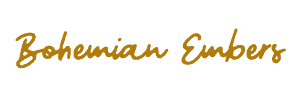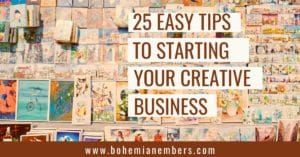Last Updated on October 13, 2022 by Hollie Giglietti
If you’re a creative person, you know how much joy it can bring to your life.
It’s not just the satisfaction of making something beautiful or the feeling of accomplishment as you put your vision into action.
It’s also the feeling of knowing that you can take your creativity, resourcefulness and creative thinking and create your own creative business that you love and are passionate about!
Welcome to DAY 12 in our Reignite Your Creative Life & Business Challenge. If you’re just finding the challenge, click the image below to sign up and start at DAY 1!
When you sign up, you’ll receive one small tip a day to reignite your creative life so you can start living in your creative purpose again.

On DAY 12 we’re talking about taking your creativity and using it to build a creative business that can help you lead a more passionate life of adventure and freedom.
I’ve been highly creative my entire life. Creativity has run through my blood since I was a child. I love to sing, take pictures, write, paint, make multimedia collages, repurpose clothing, make crafts, sew and create boho inspired repurposed home decor.
I’ve also always had a deep desire to help others.
There came a point in my life, as I was working in a regular, (non-creative) 9 to 5 job that I realized I wanted to make the transition to eventually working in a creative job of my own, where I could help people.
I haven’t transitioned out of my full-time job yet but I’m definitely on my way!
When I made a decision to start my creative business a few years ago, I started a blog and website, earned my Integrative & Wellness Life Coach Certification and started learning everything there was to know about owning my own business and starting a blog.
Throughout the years I’ve created handmade merch, drop shipping merch and social media assets for my singer songwriter husband, Kristian. I’ve also helped him start and sustain a creative side hustle, making an additional income with his craft.
And I’ve continued writing blog posts, opened an Etsy shop, and this year have been working on creating digital products, a membership and creative community and personal brand on TikTok.
This sounds awesome but how do you get started?
If you’ve always thought there had to be more to life and you knew it involved your creativity, you may have thought about turning it in to a business before – but where do you start?
Below you’ll find 4 steps to think through. Get out your journal and write your answers down to work through these;
1. Figure out your unique creativity
Creativity is a skill set that can be developed and strengthened with practice.
But it’s important to understand that we all express creativity in different ways and have different strengths, talents and creative abilities.
To start figuring out your unique creativity, try answering these questions:
- What comes naturally to you?
- What interests you the most?
- What do you like to do in your free time?
- What have you always wanted to try?
- What are your strengths?
- What skills have you honed over time?
- What do you find challenging?
- What have you always wanted to learn more about?
By exploring each of these questions, you’ll start to get a sense of your inherent creative abilities. What you’ll notice is that as a creative entrepreneur, you can draw upon more than one skill set.
You can also learn more and get better at your abilities; it doesn’t have to just be what comes really easy to you!
2. figure out your Unique Skills
Once you’ve explored your personal creative abilities, you can start to identify some of the skills that have helped you succeed in the past.
Perhaps you have a knack for communication, or you’re skilled at problem solving.
Maybe you excel at sales, or you have a knack for finance. Keep in mind that your skills might overlap. For example, if you’re a great communicator, you likely have excellent verbal and written communication skills.
Here are a few examples of skills you could have;
Creativity: The ability to think outside the box, to come up with new ideas and solutions that may be outside your normal range of thinking.
Clarity: The ability to see the big picture, to understand where your business is going and what it needs to do to get there.
Creative problem-solving: The ability to solve problems in a creative way.
Commercial awareness: The ability to understand what’s happening in your industry and what opportunities exist within it.
Entrepreneurial spirit: The ability to take risks and act on opportunities.
Flexibility: The ability to adapt to changing situations and make changes to your plans as needed.
Figuring out what your unique creative abilities are will help you to better understand how you operate as a Creative Entrepreneur.
3. Leverage the Power of Your Unique Form of Creativity
Once you’ve identified your unique creative abilities and skills, you’ll want to define your brand’s USP or Unique Selling Proposition.
Your brand’s unique selling proposition is a short summary of what sets you apart from your competitors.
What makes you different from everyone else?
What do you want your customers to know about your brand? What do you want them to remember? What do you want them to be drawn to?
Let’s say you’re a photographer and you take photos of everything, and you try to sell those photos to everyone?
Or…
You’re a photographer who takes quirky pictures of cat owners with their cats and has built their brand and community around cats and people who love them.
Which one do you think will sell more photos?
What you choose for your brand’s USP will depend on your creative abilities, interests and strengths.
This is a critical step in knowing how to be a creative entrepreneur, as it will help you to connect with your ideal clients on a much deeper level and set you MILES apart from other artists and creatives.
4. take your time with this and don’t be overwhelmed.
To be successful in this business, you have to nurture your creative vision.
You have to make time for it every day so that it grows stronger and more resilient than ever before.
Create something every day — even if it’s just a note or a sketch — this will help you stay in your creative flow and be open to new ideas.
There is great satisfaction in being able to create something beautiful; something worthwhile that can touch others’ lives with meaning and purpose beyond just making money for yourself (which is important too).
5. Find a Creative Community
If you are struggling to figure out how you can use your creativity, skills and abilities and turn it in to a business, join a community of other Creative Entrepreneur’s!
Sometimes we’re too close to our talent and can’t see how special we actually are. When you surround yourself with other like-minded Creatives, the possibilities are endless.
The creative business possibilities are endless
If you’re a highly creative person you have the ability to make something out of nothing.
So, if you’re ready to turn your creative genius into your creative business, then I encourage you in this: work on your skills, plan for success and be flexible about how things go.
The important thing is not to get overwhelmed by the details of how to start a business but rather focus on using those skills that come naturally from being creative.
You might just end up with something amazing!
Tell us in the comments what creative business ideas you have! What questions do you have about starting a creative business and what’s holding you back?





[…] Welcome to DAY 13 of our Reignite Your Creative Life and Business Challenge! In yesterday’s post we talked about how to turn your creative genius into your creative business. […]